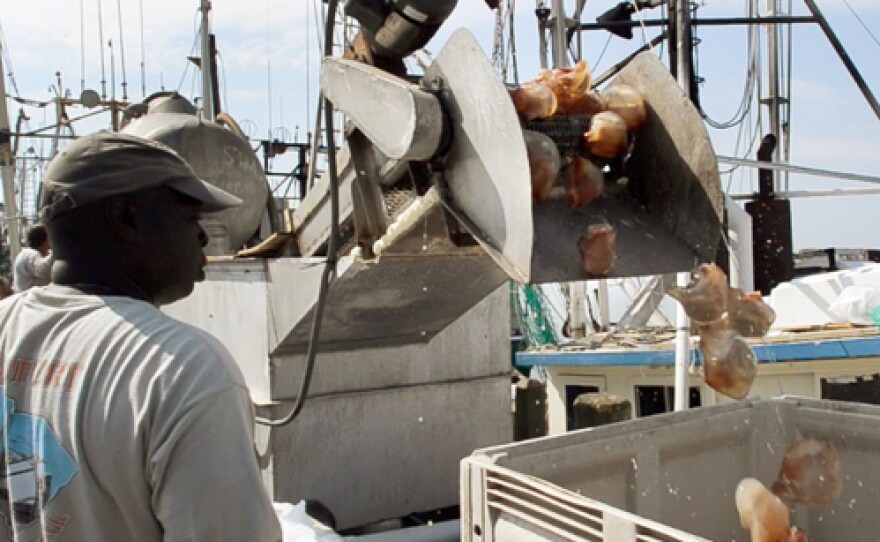

On the Southeast coast of the U.S., jellyfish have earned a lengthy rap sheet for stinging beachgoers and getting tangled in shrimpers' net. But lately, the tides have turned for shrimping, and some fishermen in South Carolina, Georgia and Florida are reaping profits from their local pests, the cannonball jellyfish, or "jellyballs."
"The shrimp season [of 2013] was the worst ever in history here," says Howell Boone, a shrimp trawler in Darien, Ga."The jellyfish industry has been about the best thing that's happened to us."
The cannonball's gelatinous flesh is notoriously bland, and there's never been much of a market for it in the U.S. But there's a big market for it in countries like China and Japan, where people have been salting, drying and rehydrating jellyfish in soups for centuries. There, the cannonball jellyfish is prized but hard to come by, and believed to have medicinal properties -- like alleviating arthritis pain.
Nobody knows exactly how many cannonball jellyfish are floating along the coast, but Jim Page, a marine biologist and jellyfish specialist with the Georgia Department of Natural Resources, says the schools that drift near the surface during the winter and spring are so dense that a boat can fill its trawl net in five minutes and bring in 100,000 pounds in a day. Page adds that fishermen who leave their gear in the water too long can easily overload their nets with so many jellyfish that the haul cannot even be winched aboard.
"It sometimes looks like you can walk on the jellyfish, they're so thick," says Steven Giese, who is helping to launch a new processing plant in Seabrook, S.C., called Carolina Jelly Balls.
The plant, which is slated to open in February, will be able to salt, dry and export 5 million pounds of jellyfish per week, says Giese. A similar plant in Georgia is handling about 1 million pounds per week. The jellyfish fishery is now Georgia's third largest by weight landed, after blue crab and shrimp, according to Page.
The irony of the Southeast's fledgling jellyfish industry is that the creatures were once despised for clogging nets. Now, fishermen are making $5,000 to $10,000 in a day of jellyfish trawling, Giese says.
"In one jellyfish season, a fisherman can make as much money as he makes in three or four shrimp seasons," Giese says.
The catch is so far mostly going to Asia. However, Giese's hope is to persuade Americans to appreciate the "delicious crunch" of jellyfish, which he says can be especially tasty in spicy soups and noodle dishes.
Some doubt Americans will take the bait. Casson Trenor, founder of Tataki Sushi and Sake Bar in San Francisco, says he once featured a jellyfish salad on his menu. The item, dressed with a ponzu vinaigrette, never became popular and was eventually retired.
"It's never something that will be a person's first choice," he says.
Whether or not jellyfish ever conquer the American dinner plate, they're having a field day in the ocean. As many species of sea life decline due to overfishing and environmental changes, jellyfish populations are thriving. They can even live in oxygen-deprived "dead-zones" when most other sea life is absent.
Though cannonball jellyfish are abundant in the Southeast, some conservationists are concerned that the the fishery is moving forward too quickly.
"If they're looking to ramp up this fishery, they really need to understand the effects it could have," says Gib Brogan, an East Coast fisheries analyst with Oceana.
One effect could be on sea turtles, Brogan says. Cannonballs, which are only mildly venomous as jellyfish go, are a favorite food of the endangered leatherback sea turtle. The turtles eat hundreds of jellyfish per day, Brogan says, and he believes there is a high probability that turtles will be caught in the nets.
Most boats, though, use "turtle excluder devices" or TEDs, which feature a grate of spaced metal bars angled toward an escape hatch and meant to save sea turtles from drowning in trawl nets.
Regardless of how well fishermen protect turtles, Trenor, the sushi bar owner, feels that the emerging U.S. jellyfish industry is the sign of a grim future -- one in which tastier sea creatures have dwindled or vanished.
"The fact that major American vessels are now targeting jellyfish indicates a major cultural shift," Trenor says. "It means we're in trouble."
Copyright 2014 NPR. To see more, visit www.npr.org.






